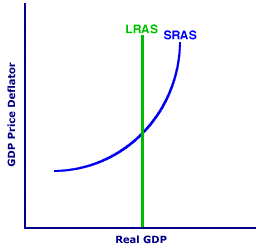
|
|
KEYNES, JOHN MAYNARD: A British economist (born--1883, died--1946) who is most noted for his work The General Theory of Employment, Interest, and Money, published 1936. The The General Theory revolutionized economic theory of the day, forming the foundation of Keynesian economics and creating the modern study of macroeconomics. Keynes was a well-known and highly respected economist prior to publication of The General Theory, however, this revolutionary work guaranteed Keynes a place as one of the most influential economists of all time.
Visit the GLOSS*arama
|
|


|

|
                           OUTPUT GAPS: Recessionary and inflationary gaps created by differences between equilibrium real production achieved by the short-run aggregate market and full-employment real production. A recessionary gap occurs if short-run equilibrium real production is less than full-employment real production. An inflationary gap results if short-run real equilibrium production is greater than full-employment real production. An output gap emerges when the short-run equilibrium generates a level of real production that differs from the full-employment level of real production. Real production less than full employment is a recessionary gap and real production greater than full employment is an inflationary gap.These two output gaps reflect a fundamental aspect of macroeconomics, including most notably the analysis of business cycles and the problems of unemployment and inflation, that perpetually puzzle political leaders. Unemployment is the prime problem of a business-cycle contraction which corresponds to a recessionary gap in the aggregate market. Inflation is the key problem that emerges during a business-cycle expansion which corresponds with an inflationary gap. | Output Gaps |  |
The aggregate market presented in the exhibit to the right provides the basis for understanding these two output gaps. The vertical curve labeled LRAS is the long-run aggregate supply curve which marks full-employment real production. Long-run equilibrium in the aggregate market necessarily results in full-employment real production.The positively-sloped curve labeled SRAS is the short-run aggregate supply curve. Short-run equilibrium in the aggregate market occurs at the price level and real production corresponding with the intersection of the aggregate demand curve and this SRAS curve. The differences between short-run real production and full-employment real production then generates recessionary and inflationary gaps. However, to identify these gaps, a third curve is needed--the aggregate demand curve. This curve is not yet revealed in the graph. The positioning of the aggregate demand curve determines if a recessionary gap or inflationary gap arises. Recessionary GapFirst consider the existence of a recessionary gap. To illustrate a recessionary gap for this aggregate market, click the [Recessionary Gap] button. This button clicking reveals an aggregate demand curve more toward the left part of graph. In particular, the short-run equilibrium real production is less than full employment, a situation associated with a business-cycle recession. The difference between short-run equilibrium real production and the full-employment real production is the recessionary gap.The key consequences of this recessionary gap are, most obviously, less real production than that corresponding with full employment and, perhaps most important, more unemployment than that corresponding with full employment. Less production and more unemployment are the prime characteristics of a business-cycle contraction. A question to consider is what might cause this recessionary gap? The simple answer is that "something" disrupts the long-run aggregate market equilibrium, something creates a short-run equilibrium at less that the full-employment level of real production. But what? In general any shock that shifts one of the three curves--AD, SRAS, or LRAS--can create this recessionary gap. But while any of the three curves could do this, a shift of the AD is the most likely cause. Inflationary GapNow consider an inflationary gap. To illustrate an inflationary gap in the aggregate market, click the [Inflationary Gap] button. This button clicking reveals an aggregate demand curve positioned more toward the right part of graph. In particular, the short-run equilibrium real production is greater than full employment, a situation associated with a business-cycle expansion that has gotten out of hand. The difference between short-run equilibrium real production and the full-employment real production is the inflationary gap.The key consequences of this inflationary gap are, most obviously, more real production than that corresponding with full employment and, perhaps most important but less obvious, a tendency for greater inflation. Excessive production and inflation are the prime characteristics of a business-cycle expansion that has become excessive. It is also important to consider the cause of this inflationary gap? Once again, any shock that shifts one of the three curves--AD, SRAS, or LRAS--can create this inflationary gap. But while any of the three curves could do the trick, a shift of the AD also tends to be the most likely cause.

Recommended Citation:OUTPUT GAPS, AmosWEB Encyclonomic WEB*pedia, http://www.AmosWEB.com, AmosWEB LLC, 2000-2025. [Accessed: July 18, 2025].
Check Out These Related Terms... | | | | | | | | |
Or For A Little Background... | | | | | | | | | | | | | | |
And For Further Study... | | | | | | | |
Search Again?
Back to the WEB*pedia
|



|

|
BLUE PLACIDOLA
[What's This?]
Today, you are likely to spend a great deal of time searching the newspaper want ads looking to buy either a wall poster commemorating the first day of winter or blue cotton balls. Be on the lookout for rusty deck screws.
Your Complete Scope
This isn't me! What am I?
|

|
|
The portrait on the quarter is a more accurate likeness of George Washington than that on the dollar bill.
|

|
|
"A winner is someone who recognizes his God-given talents, works his tail off to develop them into skills, and uses those skills to accomplish his goals. " -- Larry Bird, basketball player
|

|
GEB
Games and Economic Behavior
|

|
|
Tell us what you think about AmosWEB. Like what you see? Have suggestions for improvements? Let us know. Click the User Feedback link.
User Feedback
|


|


